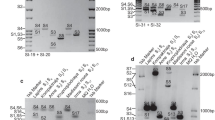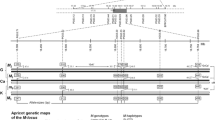Abstract
Self-compatibility is a major breeding objective in sweet cherry. The identification and characterization of new sources of self-compatibility will be useful for breeding and research purposes. In this work, self-compatibility of four local Spanish sweet cherry varieties was investigated by crossing experiments and molecular genetic analysis of two self-incompatibility loci. Crossing experiments included self- and cross-pollinations in the laboratory followed by microscopic observation of pollen tube growth and fruit set assay in the field. After crossing experiments, two accessions, ‘Son Miró’ and ‘Talegal Ahín’, were self-compatible while the other two were self-incompatible. Inheritance of S-locus and microsatellite EMPaS02 (linked to self-compatibility, Sc) were investigated in self-pollination progeny of both self-compatible genotypes. Results indicate that self-compatibility in ‘Talegal Ahín’ is similar to self-compatibility described in sweet cherry ‘Cristobalina’ and may be caused by the same mutation. That is a pollen part mutation not linked to the S-locus but linked to microsatellite EMPaS02 in cherry LG3. In ‘Son Miró’ self-compatibility seems more complex, affecting pollen and style function, and probably involving more than one mutation not described previously in sweet cherry. Together with ‘Cristobalina’, the newly described self-compatible varieties ‘Son Miró’ and ‘Talegal Ahín’ confirm the existence of unique self-compatible plant material in local germplasm from Spain that should be conserved and characterized for its use in breeding and research.
Similar content being viewed by others
References
Bargioni G (1996) Sweet cherry scions: characteristics of the principal commercial cultivars, breeding objectives and methods. In: Webster AD, Looney NE (eds) Cherries: crop physiology, production and uses. CAB International, Wallingford, pp 73–112
Bošković R, Tobutt KR (1996) Correlation of stylar ribonuclease zymograms with incompatibility alleles in sweet cherry. Euphytica 90:245–250
Cachi AM, Wünsch A (2011) Characterization and mapping of non-S gametophyte self-compatibility in sweet cherry (Prunus avium L.). J Exp Bot 62:1847–1856
Cachi AM, Wünsch A (2014) S-genotyping of sweet cherry varieties from Spain and S-locus diversity in Europe. Euphytica 197:229–236
Cachi AM, Hedhly A, Hormaza JI, Wünsch A (2014a) Pollen tube growth in the self-compatible sweet cherry genotype, ‘Cristobalina’, is slowed down after self-pollination. Ann Appl Biol 164:73–84
Cachi AM, López-Corrales M, Arbeloa A, Gella R, Wünsch A (2014b) Molecular diversity of local Spanish sweet cherry cultivars by SSR and S-locus analysis. Acta Horticult 1020:33–38
Calabrese F, Fenech L, Raimondo A (1984) Kronio: una cultivar di ciliegio molto precoce e autocompatibile. Frutticoltura 46(5):27–30
Choi C, Kappel F (2004) Inbreeding, coancestry, and founding clones of sweet cherries from North America. J Am Soc Hortic Sci 129:535–543
Clarke JB, Sargent DJ, Boskovic RI, Belaj A, Tobutt KR (2009) A cherry map from the inter-specific cross Prunus avium ‘Napoleon’ x P. nipponica based on microsatellite, gene-specific and isoenzyme markers. Tree Genet Genomes 5:41–51
Crane MB, Lawrence JC (1929) Genetical and cytological aspects of incompatibility and sterility in cultivated fruits. Jour Pomol and Hort Sci 7:276–301
Deshaies RJ (1999) SCF and cullin/RING H2-based ubiquitin ligases. Annu Rev Cell Dev Bi 15:435–467
Dirlewanger E, Claverie J, Wünsch A, Iezzoni AF (2007) Cherry. In: Kole C (ed) Genome mapping and molecular breeding in plants, Volume 4. Springer- Verlag, Berlin, pp 103–118
Hedhly A, Hormaza JI, Herrero M (2009) Global warming and sexual plant reproduction. Trends Plant Sci 14(1):30–36
Hegedűs A, Lénárt J, Halász J (2012) Sexual incompatibility in Rosaceae fruit tree species: molecular interactions and evolutionary dynamics. Biol Plantarum 56:201–209
Herrero J (coord.) (1964) Cartografía de las variedades frutales de hueso y pepita. CSIC, Aula Dei, Zaragoza
Hormaza JI (2002) Molecular characterization and similarity relationships among apricot (Prunus armeniaca L.) genotypes using simple sequence repeats. Theor Appl Genet 104:321–328
Hormaza JI, Herrero M (1996) Dynamics of pollen tube growth under different competition regimes. Sex Plant Reprod 9:153–160
Huang S, Lee HS, Karunanandaa B, Kao TH (1994) Ribonuclease activity of Petunia inflata S-proteins is essential for rejection of self-pollen. Plant Cell 6:1021–1028
Hugard J (1978) Origine du pollen et varietes pollinisatrices. Le Fruit Belge 381:11–32
Kao TH, Tsukamoto T (2004) The molecular and genetic bases of S-RNase-based self-incompatibility. Plant Cell 16:S72–S83
Lapins KO (1975) ‘Compact Stella’ cherry. Fruit Varieties J 29:20
Lewis D, Crowe LK (1954) Structure of the incompatibility gene. IV types of mutation in Prunus avium L Heredity 8:357–363
Li X, Wang X, Wei Y, Brummer EC (2011) Prevalence of segregation distortion in diploid alfalfa and its implications for genetics and breeding applications. Theor Appl Genet 123(4):667–679
Marchese A, Bošković RI, Caruso T, Raimondo A, Cutuli M, Tobutt KR (2007) A new self-compatibility haplotype in the sweet cherry ‘Kronio’, S59, attributable to a pollen-part mutation in the SFB gene. J Exp Bot 58(15/16):4347–4356
Matsumoto D, Yamane H, Abe K, Tao R (2012) Identification of a Skp1-like protein interacting with SFB, the pollen S determinant of the gametophytic self-incompatibility in Prunus. Plant Physiol 159:1252–1262
McClure BA, Haring V, Ebert PR, Anderson MA, Simpson RJ, Sakiyama F, Clarke AE (1989) Style self-incompatibility gene products of Nicotiana alata are ribonucleases. Nature 342:955–957
McClure BA, Cruz-García F, Romero C (2011) Compatibility and incompatibility in S-RNase-based systems. Ann Bot-London 108:647–658
McCubbin AG, Kao TH (2000) Molecular recognition and response in pollen and pistil interactions. Annu Rev Cell Dev Biol 16:333–364
Olmstead JW, Sebolt AM, Cabrera A, Sooriyapathirana SS, Hammar S, Iriarte G, Wang D, Chen CY, van der Knaap E, Iezzoni AF (2008) Construction of an intra-specific sweet cherry (Prunus avium L.) genetic linkage map and synteny analysis with the Prunus reference map. Tree Genet Genomes 4:897–910
Sonneveld T, Tobutt KR, Vaughan SP, Robbins TP (2005) Loss of pollen-S function in two self-compatible selections of Prunus avium is associated with deletion/mutation of an S haplotype-specific F-box gene. Plant Cell 17:37–51
Sonneveld T, Robbins TP, Tobutt KR (2006) Improved discrimination of self-incompatibility S-RNase alleles in cherry and high throughput genotyping by automated sizing intron PCR products. Plant Breed 125:305–307
Tao R, Yamane H, Sugiura A, Murayama H, Sassa H, Mori H (1999) Molecular typing of S-alleles through identification, characterization and cDNA cloning for S-RNases in sweet cherry. J Am Soc Hortic Sci 124:224–233
Tehrani G, Brown S (1992) Pollen-incompatibility and self-fertility in sweet cherry. Plant Breeding Rev 9:367–388
Ushijima K, Yamane H, Watari A, Kakehi E, Ikeda K, Hauck NR, Iezzoni AF, Tao R (2004) The S haplotype-specific F-box protein gene, SFB, is defective in self-compatible haplotypes of Prunus avium and P. mume. Plant J 39:573–586
Vaughan SP, Russell K (2004) Characterization of novel microsatellites and development of multiplex PCR for large-scale population studies in wild cherry, Prunus avium. Mol Ecol Notes 4:429–431
Vaughan SP, Russell K, Sargent DJ, Tobutt KR (2006) Isolation of S-locus F-box alleles in Prunus avium and their application in a novel method to determine self-incompatibility genotype. Theor Appl Genet 112:856–866
Vilanova S, Badenes ML, Burgos L, Martinez-Calvo J, Llacer G, Romero C (2006) Self-compatibility of two apricot selections is associated with two pollen-part mutations of different nature. Plant Physiol 142:629–641
Wu J, Gu C, Du YH, Wu HQ, Liu WS, Liu N, Lu J, Zhang SL (2011) Self-compatibility of ‘Katy’ apricot (Prunus armeniaca L.) is associated with pollen-part mutations. Sex Plant Reprod 24:23–35
Wünsch A, Hormaza JI (2004) Genetic and molecular analysis in Cristobalina sweet cherry, a spontaneous self-compatible mutant. Sex Plant Reprod 17:203–210
Wünsch A, Tao R, Hormaza JI (2010) Self-compatibility in ‘Cristobalina’ sweet cherry is not associated with duplications or modified transcription levels of S-locus genes. Plant Cell Rep 29:715–721
Yamane H, Tao R (2009) Molecular basis of self-(in)compatibility and current status of S-genotyping in rosaceous fruit trees. J Jpn Soc Hortic Sci 78:137–157
Yamane H, Ikeda K, Sassa H, Tao R (2003) A pollen expressed gene for a novel protein with an F-box motif that is very tightly linked to a gene for S-RNase in two species of cherry, Prunus cerasus and P. avium. Plant Cell Physiol 44:764–769
Zuriaga E, Molina L, Badenes ML, Romero C (2012) Physical mapping of a pollen modifier locus controlling self-incompatibility in apricot and synteny analysis within the Rosaceae. Plant Mol Biol 79:229–242
Zuriaga E, Munoz-Sanz JV, Molina L, Gisbert AD, Badenes ML, Romero C (2013) An S-locus independent pollen factor confers self-compatibility in ‘Katy’ apricot. Plos One 8(1):e53947. doi:10.1371/journal.pone.0053947
Acknowledgments
We acknowledge the collaboration of T. Bespin and R. Fustero in laboratory and field work. We also acknowledge A. Martorell (Govern de les Illes Balears, Mallorca), C.M. Pons (Mallorca) and J. Orero (Viveros Orero, Castellón) for the transfer of plant material. This work was supported by the Spanish Ministry of Science and Innovation (MICINN)-FEDER Funds research grants INIA: RF2011-00029-C03-01, RTA2009-00144-00-00, RTA2012-00103-00-00.
Data archiving statement
Genotype data was assigned tfGDR accession number tfGDR1006.
Author information
Authors and Affiliations
Corresponding author
Additional information
Communicated by E. Dirlewanger
Rights and permissions
About this article
Cite this article
Cachi, A.M., Wünsch, A. Characterization of self-compatibility in sweet cherry varieties by crossing experiments and molecular genetic analysis. Tree Genetics & Genomes 10, 1205–1212 (2014). https://doi.org/10.1007/s11295-014-0754-9
Received:
Revised:
Accepted:
Published:
Issue Date:
DOI: https://doi.org/10.1007/s11295-014-0754-9




